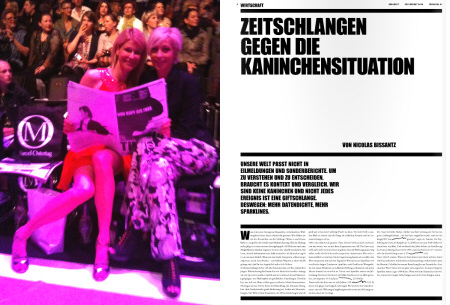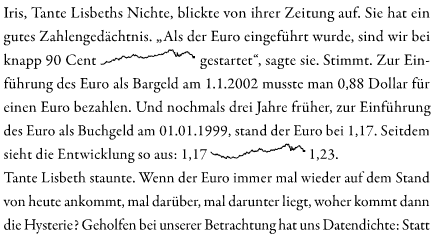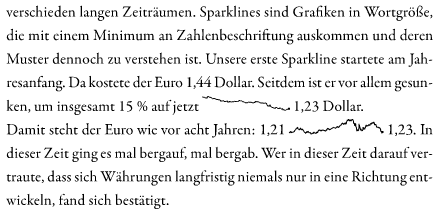Sparklines are eloquent, but monosyllabic. Literally. Dealing with line breaks is anything but easy. We explored these and other challenges in writing with sparklines.
A few weeks ago, we celebrated the fact that sportive sparklines were published in the June edition of Traffic News-to-go. For the July/August edition we tried another format: line sparklines the way that Edward Tufte suggested using them.

Showtime: The premiere for sparklines at the Fashion Week in Berlin.
Photo left: Traffic News-to-go.
This time it was a bit more difficult, but we succeeded. And we learned some things along the way. Newspapers will need to learn a few things, too, if they want to take advantage of the exciting possibilities that sparklines offer – which is something that we have encouraged them to do for quite some time now.
- Producing sport sparklines for a newspaper was relatively easy. Back in 2005, we created a special typeface called ‘SparkFont’ which consists of thousands of characters for different columns and line segments. A font, of course, prints in character width – and that is fine for dichotomous sparklines like the ones we used to show the soccer results. They only consist of simple rectangles – one above for won games, one below for lost ones. Line sparklines which are used to show e. g. exchange rates or stock prices, however, need to contain a lot more data. And that, in turn, requires graphical formats that compress the data more effectively.
- Sparklines don’t break well. The complete sparkline and the number following it all belong to a single row. We had to reword our copy or change the hyphenation in other places to avoid breaks in the sparklines. For newspapers, that means they will have a bit more challenging work before their deadlines. Without sparklines, all you need is linguistic talent to cut or add words to offset any arising gaps.
- We contemplated long and hard which length we should use to show the euro exchange rates as sparklines. After all, we are presenting time frames ranging from six months to more than 10 years per sparkline – which means that the time frames can differ by a factor of 20. We couldn’t apply Bella’s law of proportion because the shortest sparkline would have been 4 cm and largest over 80 cm long. That’s nonsense. That’s why we decided: It would be easier to identify and compare patterns if we used the same length for each sparklines.

These sparklines look much better on newspaper than on screen … - The text surrounding the sparkline has a lot of work to do. Since legends or footnotes don’t work here, we had to embed the cumbersome information for the time frame and for the time level (e. g. year, month) in the text itself. That’s hard to pack in a single sentence. As you can see in the sample text above, we solved this problem by breaking down the content into several sentences. (And in case you can read German, in one section it should say 6 years – not 8.)
- There are two types of sparklines: If we want to focus on the current number, the sparkline will show us how far away we currently are from the historical minimum and maximum. What we want to know is the current number – and it is located at the end of the sparkline, in other words, on the far right. If we want to analyze a development and pattern, we also want to know what the starting value is. That, of course, is located at the beginning or on the left. Our examples show that we sometimes need to deviate from pure doctrine to avoid a linguistic hassle.
Writing with sparklines is challenging and arduous – but the results make the extra work worth the while. A comparison can be made with a text that is considered to have a high information density because some chapters have a ratio of 13 – 24 words per ‘number word’ (i. e. years and values). Our text contains about 500 words – and the sparklines were drawn from over 10,000 values.

